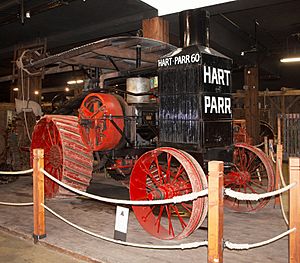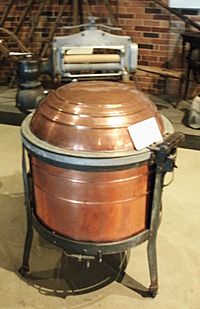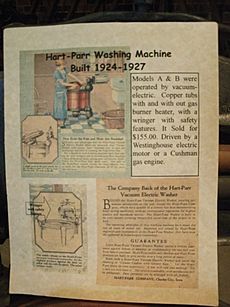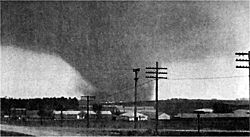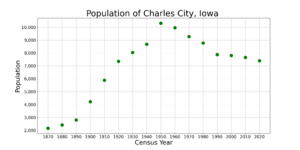Charles City, Iowa facts for kids
Quick facts for kids
Charles City, Iowa
|
|
|---|---|
|
City
|
|
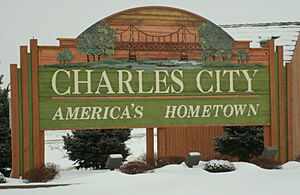 |
|
| Nickname(s):
"Chuck Town"
|
|
| Motto(s):
America's Hometown
|
|

Location of Charles City, Iowa
|
|
| Country | |
| State | |
| County | Floyd |
| Township | Saint Charles |
| Incorporated | May 1, 1869 |
| Area | |
| • Total | 6.21 sq mi (16.09 km2) |
| • Land | 6.12 sq mi (15.86 km2) |
| • Water | 0.09 sq mi (0.23 km2) |
| Elevation | 1,007 ft (307 m) |
| Population
(2020)
|
|
| • Total | 7,396 |
| • Density | 1,207.71/sq mi (466.32/km2) |
| Time zone | UTC-6 (Central (CST)) |
| • Summer (DST) | UTC-5 (CDT) |
| ZIP codes |
50616, 50620
|
| Area code(s) | 641 |
| FIPS code | 19-12765 |
| GNIS feature ID | 0455354 |
Charles City is a city in and the county seat of Floyd County, Iowa, United States. Charles City is a significant commercial and transportation center for the area. U.S. Routes 18 and 218, Iowa Highway 14, and the Canadian National and Canadian Pacific railroads serve the city. The population was 7,396 at the time of the 2020 census, a decrease of 5.3%, from 7,812 in 2000.
Contents
History
Located on the site of a Winnebago Indian village, Charles City was originally named "Charlestown" for the son of the first-known white settler to the area, Joseph Kelly. Upon his 1851 arrival to the area, Kelly envisioned the site, with its ample supply of water from the Cedar River and adjacent timberlands, as an ideal location for a town. By 1852, twenty-five other settler families had joined Kelly in that vision and a community was born. The town name changed, first to "St. Charles" and then to "Charles City," to avoid duplication of other Iowa town names.
Charles City became the county seat after Floyd County was established in 1851 and officially organized in 1854. Floyd County itself was named for Sergeant Charles Floyd of the Lewis and Clark Expedition.
Charles City is known for the role it played in the history of the American tractor. A native son Charles Walter Hart, whose father owned three local farms, met Charles H. Parr in college. After graduating from the University of Wisconsin, Hart and Parr developed a two-cylinder gasoline engine and set up their business in Charles City in 1897. It was here in 1901 the term "tractor" with Latin roots and a combination of the words traction and power was first coined by Hart and Parr. In 1903 the firm built fifteen "tractors", the first successful production-model tractor line in the U.S. The 14,000 pound No. 3 is the oldest surviving internal combustion engine tractor in the United States and is on display at the Smithsonian National Museum of American History in Washington D.C. In 1929, Hart-Parr was one of the four companies that merged to form Oliver Farm Equipment Company and finally the White Farm-New Idea Equipment Co. At its peak in the mid-1970s, the sprawling plant complex encompassed 23 acres and employed nearly 3,000 workers. The 1980s farm crisis and other economic pressures led to the closing of the plant in 1993. As of 2013, the vacant site stands ready for re-use.
Although more famously known for producing tractors, the Hart-Parr company also made some of the first washing machines. Selling for $155.00 in the 1920s, the buyer had the option of ordering either an electric or gasoline engine
The Floyd County Historical Museum preserves the plant's history and memories in an extensive collection of documents and artifacts.
National women’s rights leader Carrie Lane Chapman Catt spent her girlhood years on a farm south of Charles City. Catt is well known as a prominent leader of the woman's suffrage movement and her efforts in helping to pass the 19th Amendment ratified on August 18, 1920, granting women the right to vote. Carrie Catt was also the founder of the League of Women Voters. Her home and a visitor’s center are open for public viewing.
On June 9, 2008, record flooding caused major damage in the town. Charles City's historic suspension bridge, which crossed over the Cedar River, collapsed as well as destroyed numerous homes around the city. The City of Charles City has since received FEMA and state funding for a brand new bridge in place of the old suspension bridge. A new bridge opened in early 2010.
Charles City is the location of the Dr. Alvin L. Miller House, a Usonian home designed by Frank Lloyd Wright.
Tornados
Charles City has been devastated by tornadoes many times in its history.
In the summer of 1858 (possibly July 21) while still a village called St. Charles a "Terrific Tornado" was recorded. Although there was no deaths recorded the property value of buildings destroyed was into the thousands of dollars (1858 dollars), and the loss of crops was "must be beyond competation" according to the newspaper account.
In June 1908 (possibly June 7) a tornado destroyed or substantially damaged around 200 homes and barns. Residents W. R. Beck and a child were killed. The path of the tornado ran through the southeast part of the city missing the business district. Loss of property was fifty thousand dollars (1908 dollars).
Many people around the region remember Charles City as the site of a devastating F5 tornado that ripped through town on May 15, 1968, leaving 13 dead, hundreds injured, and massive destruction in its wake. One of the largest twisters ever recorded in the state, the storm destroyed much of the downtown – 256 businesses and 1,250 homes. Damage estimates of more than $20 million only told part of the story; the cost in human suffering was much greater than that.
Geography
According to the United States Census Bureau, the city has a total area of 6.31 square miles (16.34 km2), of which, 6.22 square miles (16.11 km2) is land and 0.09 square miles (0.23 km2) is water.
Demographics
The peak of population was in 1950. The loss of industrial jobs has led to a decline in residents.
| Historical population | ||
|---|---|---|
| Year | Pop. | ±% |
| 1870 | 2,166 | — |
| 1880 | 2,421 | +11.8% |
| 1890 | 2,802 | +15.7% |
| 1900 | 4,227 | +50.9% |
| 1910 | 5,892 | +39.4% |
| 1920 | 7,350 | +24.7% |
| 1930 | 8,039 | +9.4% |
| 1940 | 8,681 | +8.0% |
| 1950 | 10,309 | +18.8% |
| 1960 | 9,964 | −3.3% |
| 1970 | 9,268 | −7.0% |
| 1980 | 8,778 | −5.3% |
| 1990 | 7,878 | −10.3% |
| 2000 | 7,812 | −0.8% |
| 2010 | 7,652 | −2.0% |
| 2020 | 7,396 | −3.3% |
| Iowa Data Center Source: U.S. Decennial Census |
||
2020 census
As of the census of 2020, there were 7,396 people, 3,343 households, and 1,816 families residing in the city. The population density was 1,207.8 inhabitants per square mile (466.3/km2). There were 3,716 housing units at an average density of 606.8 per square mile (234.3/km2). The racial makeup of the city was 84.6% White, 5.0% Black or African American, 0.2% Native American, 3.6% Asian, 0.0% Pacific Islander, 1.9% from other races and 4.7% from two or more races. Hispanic or Latino persons of any race comprised 5.2% of the population.
Of the 3,343 households, 24.9% of which had children under the age of 18 living with them, 38.3% were married couples living together, 6.8% were cohabitating couples, 32.3% had a female householder with no spouse or partner present and 22.6% had a male householder with no spouse or partner present. 45.7% of all households were non-families. 40.8% of all households were made up of individuals, 19.2% had someone living alone who was 65 years old or older.
The median age in the city was 42.6 years. 25.1% of the residents were under the age of 20; 4.6% were between the ages of 20 and 24; 22.5% were from 25 and 44; 24.8% were from 45 and 64; and 23.0% were 65 years of age or older. The gender makeup of the city was 47.9% male and 52.1% female.
2010 census
As of the census of 2010, there were 7,652 people, 3,440 households, and 1,964 families residing in the city. The population density was 1,230.2 inhabitants per square mile (475.0/km2). There were 3,761 housing units at an average density of 604.7 per square mile (233.5/km2). The racial makeup of the city was 92.7% White, 2.5% African American, 0.2% Native American, 2.5% Asian, 0.1% Pacific Islander, 1.0% from other races, and 1.1% from two or more races. Hispanic or Latino of any race were 2.6% of the population.
There were 3,440 households, of which 26.5% had children under the age of 18 living with them, 42.5% were married couples living together, 10.5% had a female householder with no husband present, 4.1% had a male householder with no wife present, and 42.9% were non-families. 38.7% of all households were made up of individuals, and 19.1% had someone living alone who was 65 years of age or older. The average household size was 2.15 and the average family size was 2.86.
The median age in the city was 42.9 years. 23% of residents were under the age of 18; 7.7% were between the ages of 18 and 24; 21.7% were from 25 to 44; 24.5% were from 45 to 64; and 23.1% were 65 years of age or older. The gender makeup of the city was 47.0% male and 53.0% female.
Education
Charles City is served by the Charles City Community School District., which includes the Charles City High School. There were two former institutions called Charles City College, the first a Methodist college that was absorbed into Morningside College in the 1910s, and the second a short lived branch of Parsons College in the late 1960s.
The Charles City Public Library hosts the Mooney Art Collection, a set of original art prints by Rembrandt, Dali, Picasso, and Goya.
Media
Charles City is served by the following local media outlets:
- KCHA-FM 95.9 – North Iowa's Best Variety!
- KQOP-LP 94.7 FM, Charles City Educational Association
- KCHA-AM Fabulous 1580 – The Fab Oldies Channel!
- Charles City Press
Notable people
- Jeff Betts (born 1970), three time Soccer All Star and the 2000 World Indoor Soccer League Coach of the Year
- Pansy E. Black (1890–1957), science fiction and fantasy writer
- Phil Cade (1916–2001), racing driver
- Carrie Chapman Catt (1859–1947), president of the NAWSA, founder of the League of Women Voters and IAW
- Robert Coover (born 1932), author and academic
- James E. Gritzner (born 1947), United States federal judge
- Charles Walter Hart (1872–1937), Hart-Parr Gasoline Engine Company, coined the word tractor
- Mark Kuhn (born 1950), politician and Iowa State Representative from the 14th District
- Vive Lindaman (1877–1927), professional baseball player who pitched in the Major Leagues from 1906 to 1909
- Marlys Millhiser (1938–2017), author of mysteries (Charlie Greene series) and stand-alone horror novels, such as The Mirror
- George Nelson (born 1950), astronaut participated in three missions
- Henry Otis Pratt (1838–1931), two-term Republican U.S. Representative from Iowa's 4th congressional district
- Paul F. Riordan (1920–1944), WWII veteran, received the Medal of Honor for his actions in World War II during the Battle of Monte Cassino
- Helen M. Schultz (1898–1974), founder of the Red Ball Transportation Company, originally headquartered in Charles City
- Susie Smith (born 1960), runner-up on Survivor: Gabon
- Robert James Waller (1939–2017), author of the 1992 best-selling novel The Bridges of Madison County, which was adapted as a 1995 movie starring Meryl Streep and producer and director Clint Eastwood.
- Wimpy Winther (born 1947), professional football player in the National Football League from 1971 to 1972
See also
 In Spanish: Charles City (Iowa) para niños
In Spanish: Charles City (Iowa) para niños



